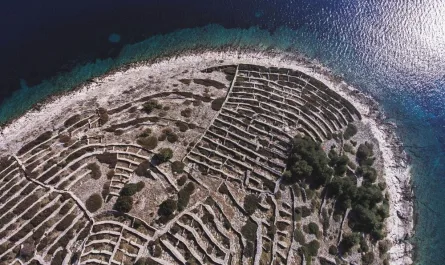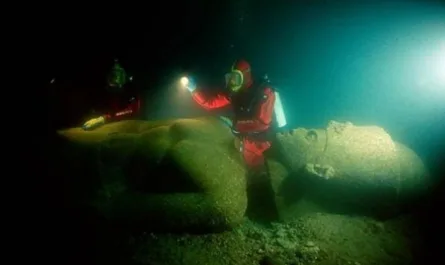A captivating image circulating online brings together three remarkable Sphinx-like rock formations from Sydney, Australia, Hinckley, Ohio, USA, and Giza, Egypt, showcasing their striking similarities and unique historical contexts. These enigmatic carvings, each set against distinct natural landscapes, have ignited widespread curiosity about their creation, cultural significance, and the mysterious threads that might connect them across continents and centuries. Let’s delve deeply into the origins, settings, and stories behind the Sydney Sphinx, the Ohio Sphinx, and the timeless Great Sphinx of Giza.
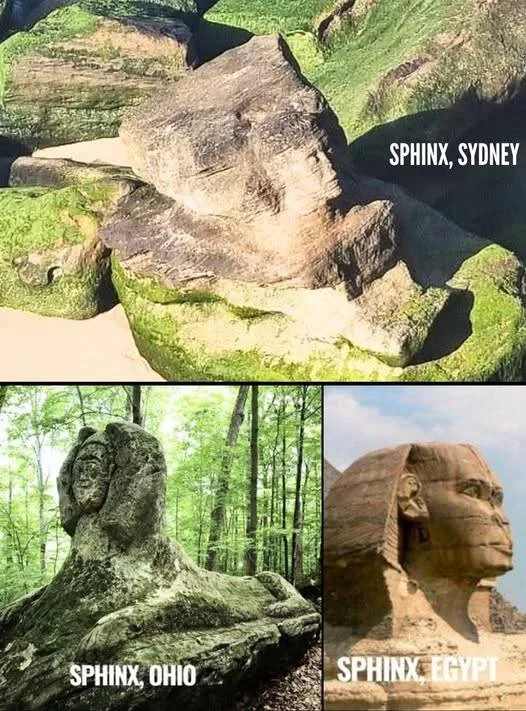
The Sydney Sphinx: A Coastal Enigma Unveiled

The uppermost image captures a moss-draped rock formation along the renowned Manly to Spit walking track, a 10-kilometer coastal trail stretching across Sydney’s northern beaches. This Sphinx-like structure, carved into the rugged sandstone cliffs, features a weathered human face emerging from a lion-like body, with half its surface cloaked in vibrant green moss—a testament to the region’s humid coastal climate. The photo, shared by local enthusiast Kevin Decosta, has gone viral, with Decosta revealing that this is just one of many sculptures scattered across the northern beaches, some located on private waterfront properties. He noted that recent weather changes, including heavy rainfall and coastal erosion, have shifted the position of the Sydney Sphinx, exposing it to new attention.
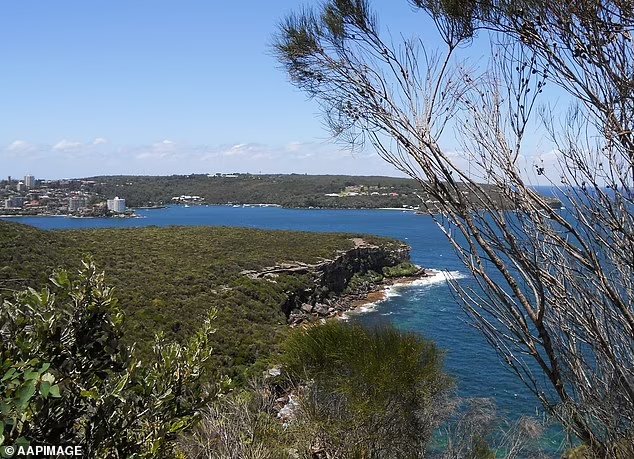
Speculation about its origins points to a community of artists who inhabited the cliffs during the 1970s, a period marked by Australia’s countercultural boom. During this time, bohemian groups embraced alternative lifestyles, often leaving behind artistic legacies in natural settings. The Sydney Sphinx might be a product of this movement, carved as an homage to ancient Egyptian iconography or simply as an act of creative rebellion. The surrounding landscape, with its sandy shores and lush vegetation, enhances the carving’s mystique. Social media responses have ranged from excitement—many adding it to their bucket lists—to surprise, with locals admitting they’ve walked the trail unaware of this hidden treasure. Preservation efforts are crucial here, as the sandstone is vulnerable to further erosion from wind and waves.

The Ohio Sphinx: A Woodland Masterpiece by Noble Stuart
The middle image transports us to Worden’s Ledges in Hinckley, Ohio, where a Sphinx-like figure emerges from the forest floor, crafted in the 1940s by local artist Noble Stuart. This sandstone sculpture, nestled within the 2,803-acre Hinckley Reservation, depicts a reclining lion with a human face, its surface weathered by decades of rain and moss growth. Stuart, a self-taught sculptor, transformed the natural ledges into an outdoor gallery, carving not only the Sphinx but also faces, animals, and abstract forms inspired by his imagination and perhaps ancient myths. The dense woodland setting, with tall trees and a carpet of ferns, contrasts sharply with the arid plains of Egypt, yet the carving’s resemblance to the Great Sphinx is unmistakable.
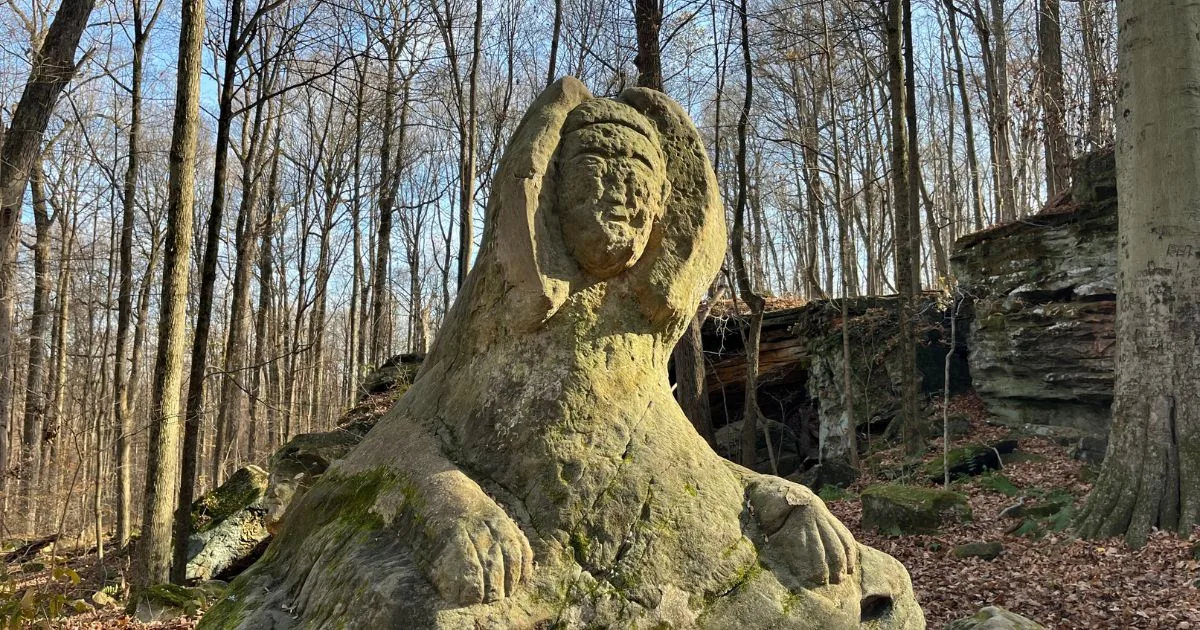
Stuart’s work began as a personal project during the post-Depression era, reflecting a blend of local pride and global inspiration. The Ohio Sphinx, standing about 6 feet tall, invites hikers to pause and ponder its story, accessible via the reservation’s network of trails. Unlike the Sydney carving, its creator is well-documented, offering a clear timeline, yet its eerie similarity to the Giza Sphinx suggests a universal artistic fascination. The site faces challenges from natural weathering, with ongoing efforts by the Cleveland Metroparks to stabilize the sandstone and protect Stuart’s legacy.
The Great Sphinx of Giza: An Ancient Architectural Marvel
The bottom image showcases the Great Sphinx of Giza, Egypt, a colossal limestone monument dating back to around 2500 BCE, during the reign of Pharaoh Khafre of the Fourth Dynasty. Carved from a single natural rock outcrop on the Giza Plateau, this iconic statue stretches 240 feet (73 meters) long and stands 66 feet (20 meters) high, with a human face—believed to resemble Khafre—resting atop a lion’s body. Its weathered features, eroded by millennia of wind and sand, bear the scars of time, yet it remains a symbol of ancient Egyptian power, wisdom, and mystery. Positioned near the Pyramids of Giza, the Sphinx guards the necropolis, its gaze fixed toward the rising sun, a detail tied to solar worship in Egyptian mythology.

Archaeologists suggest the Sphinx began as a yardang—a wind-sculpted rock formation—later refined by skilled artisans using copper tools and human labor. A 2023 study from New York University posits that this natural starting point was intentionally shaped to enhance its lion-like form, aligning with the Egyptians’ reverence for the animal as a protector. The surrounding desert landscape, with its golden sands and clear horizons, frames the Sphinx in stark contrast to the verdant settings of Sydney and Ohio, underscoring its ancient and monumental stature.
Shared Inspirations and Scientific Insights
The visual parallels among these Sphinxes hint at a shared human impulse to emulate the mythical creature, possibly rooted in natural phenomena. Yardangs, found in deserts worldwide, can resemble seated lions or other figures, and the Giza Sphinx’s origin as a modified yardang offers a compelling link. The Sydney and Ohio carvings, while likely human-made, may reflect artists’ observations of similar natural shapes in their environments—sandstone cliffs in Australia and ledges in Ohio. This interplay between nature and art suggests that the Sphinx form transcends culture, inspired by both geological processes and human creativity.
Cultural exchange could also play a role. The Great Sphinx’s fame, documented by Greek historians like Herodotus in the 5th century BCE, spread its image globally, potentially influencing later artists like Stuart or the Sydney cliff dwellers. Alternatively, the universal appeal of the lion-human hybrid—symbolizing strength and intellect—might explain these independent creations. Ongoing research, including 3D mapping and erosion studies, aims to uncover more about these connections.
Exploring and Preserving These Global Treasures
The Sydney Sphinx beckons adventurers along the Manly to Spit track, where a 2-3 hour hike reveals its mossy form amidst stunning coastal views. Visitors are encouraged to tread lightly, respecting the natural habitat and private lands where other sculptures may hide. In Ohio, Worden’s Ledges offers a serene trail experience, with the Sphinx accessible year-round, though visitors should watch for slippery paths after rain. The Great Sphinx, a UNESCO World Heritage site, welcomes millions annually, with guided tours exploring its history and ongoing restoration efforts to combat sand erosion.
Preservation is a shared challenge. Sydney’s coastal erosion threatens the sandstone cliffs, while Ohio’s forest climate accelerates weathering. At Giza, modern pollution and tourism impact the limestone. Local initiatives, from community cleanups in Sydney to park maintenance in Hinckley, aim to protect these sites, ensuring the Sphinx legacy endures.
A Timeless Connection Across Continents
The Sydney, Ohio, and Giza Sphinxes weave a rich tapestry of human ingenuity, from ancient Egypt’s monumental architecture to 20th-century personal art and 1970s countercultural expressions. Whether shaped by wind, chisel, or imagination, these carvings reflect a global fascination with the Sphinx mythos. As research deepens and visitors explore, these stone guardians continue to bridge past and present, inviting us to marvel at the mysteries carved into the earth’s surface.

